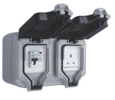If an EV charge point has sufficient RDC-DD integral RCD protection, my understanding is that this can be supplied from a non RCD circuit provided the installation method is deemed appropriate, e.g SWA.
The regulation (722.531.2.101) requiring every charging point to be double pole RCD protected is to me subjective in that it is not clearly stated whether the circuit/wiring supplying the EVCP or the EVCP itself, with integral protection must comply.
Given that an SP RCBO (typeA) provides the same protection as an MCB supplying the EVCP in say SWA with additional protection on the line supply, my view would be that is preferable to just from an MCB (where/if permitted)
Has this been clarified on here or elsewhere before ?
The regulation (722.531.2.101) requiring every charging point to be double pole RCD protected is to me subjective in that it is not clearly stated whether the circuit/wiring supplying the EVCP or the EVCP itself, with integral protection must comply.
Given that an SP RCBO (typeA) provides the same protection as an MCB supplying the EVCP in say SWA with additional protection on the line supply, my view would be that is preferable to just from an MCB (where/if permitted)
Has this been clarified on here or elsewhere before ?




